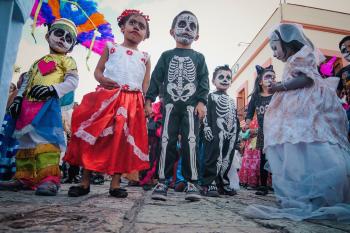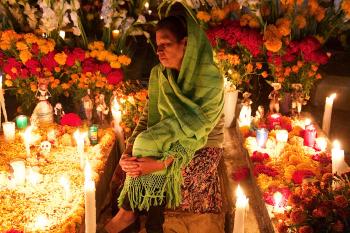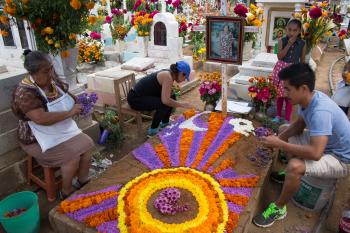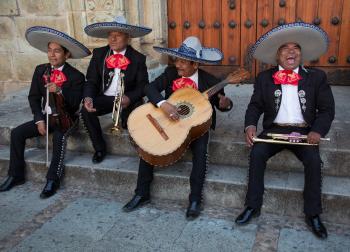Capturing the lively atmosphere of Oaxaca’s Day of the Dead
This article appears on page 20 of the August 2017 issue.
A long day of flights from Boston to Atlanta, then on to Mexico City and, finally, Oaxaca left us ready to crawl into bed upon our arrival at our final destination… had we not been met by a parade of young children marching just outside the entrance to our hotel. Called comparsas, celebratory processions like this are kickoff events for the 3-day festival called Day of the Dead, which takes place from Oct. 31 to Nov. 2 each year.
We were in Mexico to join Jim Cline Photo Tours (San Diego, CA, 877/350-1314; jimclinephototours.com) to feast on the riot of colors and activities that were to follow.
Honoring family
We stayed at the centrally located La Catrina de Alcalá, once a private home. We were only blocks away from the central plaza known as the Zócalo.
The hotel, with 11 separate rooms on two floors, was modestly priced ($110 per night) and featured its own dining room with a Oaxacan menu and a wine cellar. If visiting during Day of the Dead, check availability ahead of time because reservations there fill up quickly.
Our group of photographers hailed from all across the United States, and we came well schooled in the rituals of America’s Halloween, but we soon learned that Day of the Dead is different.
Halloween is thought to have its origins in Celtic pagan rituals celebrating the end of harvest season, when underworld souls came back to visit the living, but today it is more of a family-centered tradition that features pumpkins, scary costumes and trick-or-treating, with little reference to the visiting dead.
Day of the Dead, in comparison, had its pre-Hispanic indigenous roots in Mexico as many as 3,000 years ago and is a celebration when spirits of deceased relatives return to share memories (and candy, fruits and other food) with family and friends. It is a day of festivity, not mourning.
And while the Catholic Church does not officially recognize it, offering All Souls Day and All Saints Day in its place, Day of the Dead continues to be a cherished holiday that provides a kind of social glue in contemporary society.
Colorful costumes
Besides Jim Cline, two Oaxacan guides accompanied us everywhere we went. They were our eyes and ears as we explored the festivities.
Gabriel, our historian and translator, informed us that the late-October comparsas we saw as we arrived at our hotel were announcements for the days ahead: Día de los Angelitos (Day of the Little Angels), when the souls of children are welcomed back, on Nov. 1, and Día de los Muertos (a day for the adults), on Nov. 2.
Marching through the stone-paved streets of downtown Oaxaca were children from all of the kindergarten and elementary schools in town, each school with its own band.
Young boys were dressed in skeleton costumes and girls in twirling colorful dresses. Most had their faces painted white, eyes outlined in colors or in black, often with the edges of their lips curling up at their corners.
It was truly a family affair. We saw parents pushing baby carriages and some dancing with their daughters and sons. Marching with them were musicians playing tubas, clarinets, trumpets and trombones, while incense, mixed with the smell of roasted corn and the aroma of chocolate, wafted through the streets — a total sensory delight!
Markets and murals
Knowing the children’s comparsas would go on for several days before the main events on Nov. 1 and 2, Jim organized a field trip to one of the area’s busiest markets in the town of Ocotlán, an hour south of Oaxaca.
But before we arrived, we made a stop in a small village where artists had painted wall-sized murals of skeleton figures in honor of Day of the Dead. Walls featured cleverly painted figures of a skeletal comparsa band playing the tuba and beating a huge drum, bony men sharing a witches brew and skeletal farmers sowing marigolds, the celebratory flower that we encountered wherever we went.
In Ocotlán, the celebration was a time of sharing food as well as stories, so the markets pulsed with activity. Rows upon rows of thickly packed food stands offered items that formed the foundation of the approaching festival: tasty egg-rich pan de muertos (bread of the dead) and 6-inch-tall sugar skulls (delicacies for the children).
There were also festive and aromatic marigolds and red cockscomb flowers, the latter symbolizing the blood of Christ.
Besides these mainstays, fruits and vegetables of every sort were on sale for families to purchase. We saw oranges, lemons, apples, grapefruit and jicama, just to name a few. Then there were staples like tortillas and tamales.
Market shoppers would take their purchases home for the altars, called ofrendas, that were on display in their houses and at the cemeteries where their loved ones were buried.
Although we never saw an ofrenda in anyone’s home, not wanting to invade anyone’s privacy, we learned more about them as we strolled through the shops in Oaxaca.
We were told that the altars could be as simple as a single or 2-tiered table with a decorative cloth. On the altar might be chicken tamales with a spicy mole sauce, flowers, fruit, a glass of water, a bottle of mezcal and a photo of the deceased, all arranged under a framing arch made of sugarcane stalks.
Gabriel said the sugarcane arch was thought to represent the entrance into the world of the dead. And because mezcal, a libation similar to tequila, is considered an important part of Day of the Dead, he shared a favorite saying: “¡Para todo mal, mezcal! ¡Para todo bien, también!” (“For everything bad, there’s Mezcal! And for everything good, the same!”)
Cemetery visits
On the last day of October came our first visit to the cemeteries. This is where the true spirit of this celebration was on display.
After dinner in the Zócalo in Oaxaca, our driver, Jesus, drove us first to the town of Xoxocotlán and a very large cemetery called Cementerio Nuevo. By the time we arrived, it was jammed with visitors, and we followed Jim through a maze of gravesites brightly lit by hundreds of candles.
Some gravesites featured carpets of marigolds and cockscomb carefully arranged in a decorative display, while parents, grandparents and children sat nearby welcoming us with offers of mezcal and a variety of sweet chocolate drinks.
While many of the graves were filled with fruits, flowers and family photos, scattered nearby were simple mounds of earth with humble wooden crosses. Here and there, musicians played guitar, accordion and bass, invited by families who could afford the entertainment. It gave us a sense of what was to come.
Panteón Antiguo lay farther down the street from the bustle of Cementerio Nuevo. It was close to midnight, and there we found the atmosphere more to our liking — much more intimate. Within the surrounding walls lay the ruins of a crumbling chapel with graves all around.
We were told the cemetery was built in the 17th century on a foundation laid perhaps a century earlier. Family gatherings there were more subdued and reflective.
The graves varied from elaborate vaults each fronted by a large cross and the figure of Jesus to colorful mounds with flowers all around.
Drawing closer
On Nov. 1, Día de los Angelitos, we were entertained by more comparsas.
We left Oaxaca in the afternoon to visit four villages near the town of Etla, each of which had its own traditional version of a comparsa. The assortment of costumes rivaled anything I had seen back in the States.
Amid the almost deafening blasts of horns and trumpets strolled men on stilts with masks that resembled mountain goats. There was a ghoulish, giant version of Mickey Mouse with fake blood curling around his lips, and men were dressed in drag, with white tresses that fell to their knees.
As the evening light faded, we continued on to a nearby village to hear a battle of bands. Two groups of musicians from different towns stood facing one another at an outdoor basketball court. Firecrackers joined the drums and tubas that pulsed in waves as each group sought to outperform the other.
Before the evening ended with another raucous display of costumed dancing monsters, we found refuge in a local’s home, where our driver served us tamales steamed in traditional dried corn husks and a second batch cooked in banana leaves. We dipped sweet bread in hot chocolate and washed it all down with Corona beer and tiny cups of mezcal.
Memorable interactions
On Nov. 2, the official Day of the Dead, the cathedral bells rang and rang, announcing the festivities.
We began the day with a visit to the general cemetery, called Panteón General, which was close to our hotel. At its entrance were long walls stacked with body-sized alcoves that reminded me of the walls of graves we had observed in New Orleans.
Families who had gathered there were happy to share the moment by offering something called champurrado, a chocolate-based atole, a warm, thick drink prepared with masa de maíz (lime-treated corn dough).
To get the full flavor of the day for which this celebration was named, we drove north to the town of San Felipe del Agua, where Jim Cline wanted us to meet family friends he had visited for a decade or more. The cemetery there was smaller than the ones we had seen before, but it bustled with activity and mariachi music.
Juana Guzman is in her 80s, and she moved through the candle-lit cemetery carrying bouquets of cockscomb and marigold flowers to the different graves she felt responsible for. Having lost her husband decades before, Juana was in the company of her one remaining son and his wife — from a family that once included nine children. They surprised Jim with a bottle of mezcal and a stylish jacket as gifts for his friendship.
The details
We ended our 12-day visit (the 10-day tour cost $4,475 per person) on Nov. 4, each member of our group flying back to the States. Our small-group photo tour had included many side trips, each adding an important dimension to our experience in Oaxaca.
Not to be forgotten were our trips to noted archaeological sites such as Monte Albán and Mitla; excursions to a mezcal museum; a look at the traditional weaving village of Teotitlán del Valle; a visit to a black-pottery workshop in the town of San Bartolo Coyotepec, and a tour of the home of Zeny Fuentes, where colorful animal figures called alebrijes are produced.
The festivities in and around Oaxaca had offered a rich banquet of experiences.




